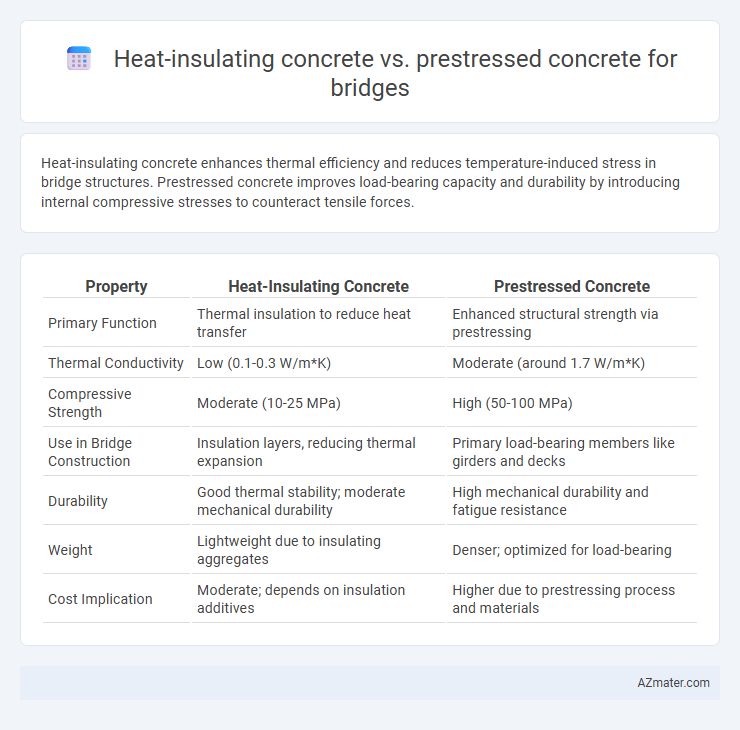Heat-insulating concrete enhances thermal efficiency and reduces temperature-induced stress in bridge structures. Prestressed concrete improves load-bearing capacity and durability by introducing internal compressive stresses to counteract tensile forces.
Table of Comparison
| Property | Heat-Insulating Concrete | Prestressed Concrete |
|---|---|---|
| Primary Function | Thermal insulation to reduce heat transfer | Enhanced structural strength via prestressing |
| Thermal Conductivity | Low (0.1-0.3 W/m*K) | Moderate (around 1.7 W/m*K) |
| Compressive Strength | Moderate (10-25 MPa) | High (50-100 MPa) |
| Use in Bridge Construction | Insulation layers, reducing thermal expansion | Primary load-bearing members like girders and decks |
| Durability | Good thermal stability; moderate mechanical durability | High mechanical durability and fatigue resistance |
| Weight | Lightweight due to insulating aggregates | Denser; optimized for load-bearing |
| Cost Implication | Moderate; depends on insulation additives | Higher due to prestressing process and materials |
Introduction to Heat-Insulating and Prestressed Concrete
Heat-insulating concrete incorporates insulating materials such as expanded polystyrene or aerogel to reduce thermal conductivity and improve energy efficiency in bridge structures, minimizing temperature-induced stress and cracking. Prestressed concrete utilizes high-tensile steel tendons tensioned before or after casting to counteract tensile stresses, enhancing load-bearing capacity and structural durability under dynamic bridge loads. Both materials address distinct challenges in bridge engineering, with heat-insulating concrete focusing on thermal performance and prestressed concrete on structural strength and service life.
Key Differences in Material Composition
Heat-insulating concrete incorporates insulating aggregates such as expanded polystyrene beads or perlite, designed to reduce thermal conductivity and enhance energy efficiency in bridge structures. Prestressed concrete utilizes high-strength steel tendons embedded under tension within the concrete matrix to improve load-bearing capacity and control tensile stresses. The primary material distinction lies in heat-insulating concrete's emphasis on thermal properties, whereas prestressed concrete prioritizes mechanical strength through prestressing elements.
Thermal Performance and Heat Resistance
Heat-insulating concrete exhibits superior thermal performance by significantly reducing heat transfer through the bridge structure, enhancing durability in extreme temperature environments. Prestressed concrete, while offering high strength and load-bearing capacity, generally has lower heat resistance and can be more susceptible to thermal expansion and contraction issues. Selecting heat-insulating concrete improves energy efficiency and protects against thermal cracking, making it ideal for bridges exposed to severe heat fluctuations.
Structural Strength and Load-Bearing Capacity
Heat-insulating concrete incorporates lightweight aggregates and insulating materials that reduce thermal conductivity while maintaining moderate compressive strength suitable for non-critical bridge components. Prestressed concrete enhances structural strength through induced compressive stresses, allowing for superior load-bearing capacity and longer spans in bridge construction. The prestressing process significantly improves crack resistance and durability under heavy traffic loads, making it preferable for main load-bearing bridge elements.
Durability and Longevity in Bridge Applications
Heat-insulating concrete enhances bridge durability by reducing thermal stress and minimizing crack formation caused by temperature fluctuations, thereby extending the structure's lifespan. Prestressed concrete improves longevity through its high tensile strength, effectively resisting bending and tensile forces, which reduces concrete fatigue and structural deterioration over time. Combining heat-insulating properties with prestressed techniques can optimize durability in bridge applications by mitigating environmental damage and mechanical stress simultaneously.
Installation Techniques and Construction Processes
Heat-insulating concrete for bridges employs advanced lightweight aggregates and insulating additives, allowing for reduced thermal bridging and enhanced energy efficiency during installation through conventional casting and curing methods. Prestressed concrete involves tensioning high-strength steel tendons either before or after casting the concrete, requiring precise anchoring systems and specialized tensioning equipment for effective load distribution and structural integrity. Construction processes for prestressed concrete demand tighter quality control and staged tensioning sequences, whereas heat-insulating concrete installation focuses on maintaining insulation properties while ensuring proper bonding and curing conditions.
Cost Analysis and Economic Considerations
Heat-insulating concrete typically offers higher initial material costs due to specialized additives and enhanced thermal efficiency, reducing long-term energy expenses by minimizing temperature-related degradation. Prestressed concrete, while generally more expensive in terms of fabrication and installation due to tensioning equipment and labor, provides superior load-bearing capacity and durability, leading to lower maintenance and service life extension costs. Economic considerations must balance upfront expenditures against operational savings, with heat-insulating concrete favoring climates demanding thermal regulation and prestressed concrete excelling in infrastructure requiring higher structural performance.
Environmental Impact and Sustainability
Heat-insulating concrete enhances energy efficiency by reducing thermal bridging and minimizing heat loss, which lowers the carbon footprint during the bridge's operational life. Prestressed concrete offers material optimization by reducing the volume of concrete and steel required, leading to less resource consumption and decreased CO2 emissions in construction. Both materials contribute to sustainability, but heat-insulating concrete promotes long-term energy savings, while prestressed concrete optimizes resource utilization and structural durability.
Maintenance Requirements and Life Cycle
Heat-insulating concrete for bridges reduces thermal stress, minimizing crack formation and lowering maintenance frequency compared to prestressed concrete, which requires regular monitoring and tension adjustments of the steel tendons. Life cycle costs for heat-insulating concrete tend to be lower due to enhanced durability and resistance to temperature fluctuations, whereas prestressed concrete, despite its high initial strength and load capacity, involves higher long-term expenses linked to tendon corrosion protection and periodic inspections. Optimizing material selection based on climate and load conditions extends bridge lifespan and reduces overall maintenance interventions.
Suitability for Various Bridge Types and Climates
Heat-insulating concrete excels in environments with extreme temperature fluctuations, providing enhanced thermal regulation for bridge decks in regions prone to freeze-thaw cycles, while prestressed concrete offers superior tensile strength, making it ideal for long-span bridges and heavy load applications. In cold climates, heat-insulating concrete reduces the risk of ice formation and structural damage, whereas prestressed concrete maintains structural integrity under high-stress conditions in both urban and coastal bridges. Selecting the appropriate material depends on the specific climate challenges and structural demands of the bridge type, optimizing durability and lifespan.

Infographic: Heat-insulating concrete vs Prestressed concrete for Bridge
 azmater.com
azmater.com